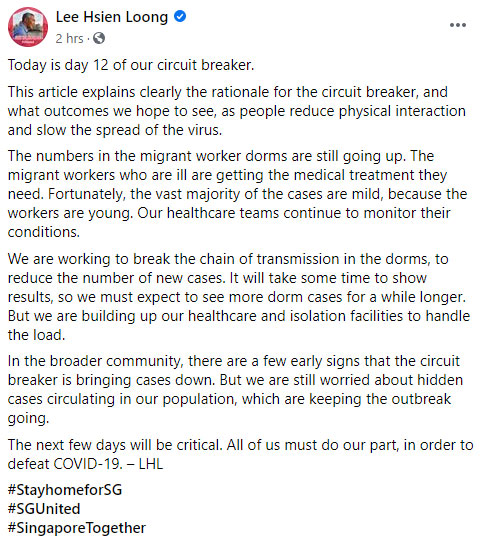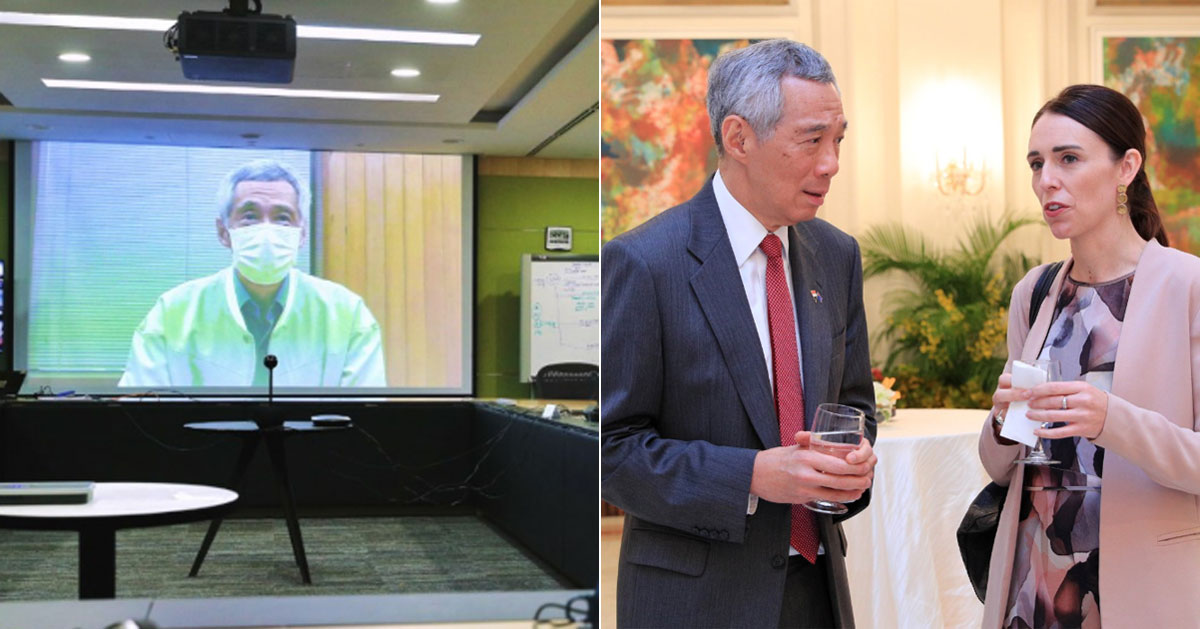Prime Minister Lee Hsien Loong has put out a sobering message to Singaporeans on Day 12 of the Covid-19 circuit breaker period.
In a Facebook post on April 18, PM Lee gave a nod to the 12th day milestone as he wrote that Singapore is determined to break the Covid-19 transmission in foreign worker dormitories.
The reason for the 12th day acknowledgement was due to how New Zealand successfully turned things around after 11 days of lockdown measures.
However, PM Lee was circumspect as he explained that infections in foreign worker dormitories in Singapore will continue for a while, as the country beefs up its healthcare and isolation facilities "to handle the load".
PM Lee also shared a mainstream media article about the rationale for the circuit breaker, and what outcomes are desirable.
PM Lee's post can be read in full here, while the rationale for the circuit breaker is summarised below:
Today is day 12 of our circuit breaker.
This article explains clearly the rationale for the circuit breaker, and what outcomes we hope to see, as people reduce physical interaction and slow the spread of the virus.
The numbers in the migrant worker dorms are still going up. The migrant workers who are ill are getting the medical treatment they need. Fortunately, the vast majority of the cases are mild, because the workers are young. Our healthcare teams continue to monitor their conditions.
We are working to break the chain of transmission in the dorms, to reduce the number of new cases. It will take some time to show results, so we must expect to see more dorm cases for a while longer. But we are building up our healthcare and isolation facilities to handle the load.
In the broader community, there are a few early signs that the circuit breaker is bringing cases down. But we are still worried about hidden cases circulating in our population, which are keeping the outbreak going.
The next few days will be critical. All of us must do our part, in order to defeat COVID-19. – LHL
#StayhomeforSG
#SGUnited
#SingaporeTogether

Summary of what circuit breaker aims to do
Essentially, the verdict by experts is that costly circuit breaker measures are not failing.
Why is the 12th day important?
The 11th day mark was an anticipated milestone for New Zealand, which imposed a two-week long nationwide lockdown on March 25.
The country reported a positive turnaround in its number of new cases on Day 11, its prime minister Jacinda Ardern had said.
However, Singapore is not at the inflection point that other countries were when they imposed similar lockdowns on people movement.
Cases in the community have dropped
The number of new cases in the Singapore community has dropped, from an average of 40 cases a day in the week before, to an average of 32 a day in the past week.
But it is still early days as the numbers can creep back up.
There are problems though.
It is still difficult to link new cases and identify the source of infection.
The number of new cases in the community with no known links to past cases or existing clusters has gone up slightly.
The increase is from an average of 19 cases a day the week before, to an average of 22 a day in the past week.
There are also undetected cases in the community based on random testing of patients now in government hospitals.
When does circuit breakers really help?
The circuit breaker targets the the number of contacts between infectious persons and other susceptible individuals.
The slower the viral spread, the more bandwidth the healthcare system have.
Singapore’s circuit breaker was a pre-emptive move, and was not imposed only after infections have spread wildly.
Singapore took New Zealand's lead in imposing the restriction of movement of individuals but compliance in Singapore is more of an issue.
The coronavirus has infected around 3,000 migrant workers so far, making them the biggest group out of the 5,050 cases in Singapore, so treating their cases differently is necessary given their sheer size.
But a surge of cases in any one group hurts by taxing the national healthcare capacity.
At the moment, Singapore health authorities are testing some 5,000 workers this week, to get those who are well to relocate.
More tests are needed, such as 20,000 swab tests each day, to effectively control the virus spread.
If you like what you read, follow us on Facebook, Instagram, Twitter and Telegram to get the latest updates.
